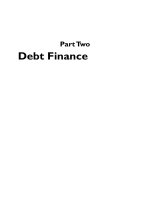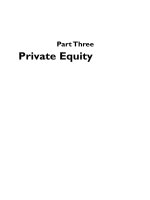Tài liệu Corporate Finance handbook Chapter 5 doc
Bạn đang xem bản rút gọn của tài liệu. Xem và tải ngay bản đầy đủ của tài liệu tại đây (258.05 KB, 50 trang )
Part Five
Mergers and
Acquisitions
5.1
Buying a Business
David Houghton
TMG Corporate Finance
Introduction
UK merger and acquisition activity totalled approximately £329 billion
during 2000, consisting of 3,049 deals (source: Thompson Financial
Securities Data).
Trends in deal activity generally coincide with the wider economic
situation; merger and acquisition (M&A) activity levels are often subject
to the availability of new external funding in both the private and
public equity markets, which in turn is dependent upon economic
confidence in the United Kingdom and abroad.
Recently, economic conditions in the world’s largest economy, the
United States, deteriorated significantly as both sales and production
weakened. In response, US interest rates were cut to ease the debt
burden and stimulate a recovery in equity prices.
Changes in the US economy have been reflected in a more
moderate slow down in the United Kingdom and the Eurozone.
Predictions for the UK economy indicate that it will achieve a rela-
tively soft landing, in line with the latest Treasury consensus forecast
for 2001. Hence, it is hoped that activity in the UK M&A market will be
only moderately affected in the short and medium term.
Motives for buying
The rationale for buying businesses usually includes one or more of
the following:
•
consolidation – purchase of a competitor to strengthen a company’s
position, by increasing their critical mass and hence their buying
power;
•
market protection – defensive move to prevent another competitor
buying the same target;
•
diversification – through the purchase of a company in a related
industry, a purchaser can diversify their product range, cross-selling
related products to new customers in the same market sectors;
•
new markets – widening geographic coverage, through the
purchase of a business located in new markets;
•
synergies – a common theme running through all corporate acqui-
sition strategies is that of synergistic benefits, ie cost savings by
amalgamating overheads and stripping out any inappropriate
duplication;
•
market value enhancement – in the quoted company market, prices
paid for businesses should result in an enhancement in the value of
the newly formed group, beyond the sum of the two separate parts,
ie the multiple of profits paid for the target should be less than the
trading multiple of the purchaser, therefore immediately enhancing
the value of the purchaser’s enlarged group;
•
Management buy-outs and management buy-ins (MBOs and MBIs)
– existing or new management teams seeking to buy businesses and
grow them under their own strategies;
•
institutional purchases – financial institutions buying businesses to
add to existing investments, or to back new management teams –
normally with a view to selling in the medium term.
Notwithstanding the above logical reasons for purchasing a
business, almost every acquisition leads to problems beyond those
envisaged. Integrating different management teams with different
cultures and ideals and achieving effective cross-selling and effi-
ciencies can be a lengthy process. Getting it wrong can be disastrous
and many ill-advised purchases have brought down substantial
groups in the past.
172 Mergers and Acquisitions
Valuing a business
Owner-managed sector
There are two principal methods for valuing a private limited business.
The first is based on a company’s net assets and is usually applied
where the profit stream has been erratic, where losses have been
incurred, or where the future of the business is highly dependent on
the owner-manager’s personal relationships with providers of work.
In these circumstances, a price for goodwill is hard to justify.
The second method is based on the expected future profit stream.
This is usually applied when the company has a profitable track
record and the business is of such a size that it is the company name
and reputation, rather than that of its owners, which is the main
reason it continues to gain new business.
Although price is critical, other considerations such as loss of
business independence and the long-term interests of employees are
often just as important to the vendor. Where family businesses are
concerned, there may also be a number of shareholders involved who
have differing requirements.
Public company sector
A quoted company’s value is publicly available and is equivalent to its
share price, as traded on the stock market, multiplied by the number
of shares in issue, ie its market capitalisation. Shares are traded at
prices that reflect the market’s view of the future growth prospects of
that stock. When buying a publicly quoted company, the purchaser
generally pays a price which includes a premium above its quoted
price, to entice the shareholders into selling.
Structuring a purchase
Deals generally involve a combination of cash, shares and deferred
consideration; it is rare for a purchaser to pay the full consideration in
cash at completion.
Shares in the new combined business may well be attractive to a
vendor if, for example, they are ordinary shares in a quoted company
and the vendor has banked or guaranteed a substantial amount of
their consideration already.
Buying a Business 173
Purchasers and their financiers generally prefer a structure that
involves the vendor deferring a tranche of their consideration, payable
at a future date. The deferral is often in the form of loan notes or
redeemable preference shares, which often attract returns greater than
the vendor could achieve in the external market place. The issue here
is to make the vendor comfortable that their deferred consideration
will be as safe as reasonably possible. This is often achieved by the
vendor remaining involved in a consultancy capacity post-acquisition,
for example, until their deferred consideration is realised.
Another term often used in deal structures is ‘earn out’. This
arrangement is often employed where the target company has consid-
erable growth potential in the short term but needs an alliance with a
larger organisation in order to achieve it, for example. The target’s
existing shareholders often remain with the company post-deal and
hence continue to influence its growth. Consequently, a deal for their
shares involving a ratchet, triggered by certain levels of future prof-
itability, is often appropriate to both sides.
Interestingly, the introduction of taper relief for capital gains tax over
the last few years, has led many vendors to prefer deferring their consid-
eration, as the effective tax rate falls to as little as 10 per cent by April 2002.
Consequently, vendors wishing to crystallise the value of their shares
over the last couple of years, but not suffer higher rates of tax, have opted
to defer their consideration usually into some form of fully secured
instrument, to be realised at future dates.
Enfranchising the target’s management
Ensuring that the management team of the target, who are often
nervous about what life is going to be like post-acquisition, are fully on
board and incentivised properly to take the business forward is key to
any successful purchase. Without cohesive senior management teams
sharing the same goals, any integration is going to be fraught.
The introduction of a suitable share option scheme is commonly
used, giving individuals a feeling of personal financial participation in
the future growth of the business. Numerous Inland Revenue-
approved schemes exist, varying from widely recognised quoted
company schemes to, say, employee benefit trusts in private limited
companies and ‘phantom share option schemes’, which are effectively
bonus arrangements with favourable tax structures.
174 Mergers and Acquisitions
Funding an acquisition
Owner-managed sector
The three principal sources of external acquisition finance are debt,
equity and mezzanine. The right mix of funding is key to providing
the foundation for success post-acquisition; appropriate gearing levels
are crucial to avoid overstretching the company’s finances. A strong
working relationship with the funders is also required and therefore
partnering with the right group of funders is also essential.
Debt
Debt finance, ie secured lending against a company’s assets that
attracts interest, can be structured in many different ways ranging
from traditional overdraft and term facilities with a bank, to more
specialised asset-based facilities and revolving credit arrangements.
The level of debt facilities offered by lenders is based upon future cash
flow projections and asset cover.
Equity
Equity finance does not carry any security and normally attracts
dividend income, not interest. It is also longer-term, often involving
no repayments of capital in the early years. However, to balance the
risk of being unsecured, the reward is considerably more than that of a
debt provider. Returns in the order of 30–35 per cent per year are
generally sought by equity investors and hence the growth profile of
the businesses post-acquisition needs to be substantial.
Equity investment, in funding purchases of businesses in the
owner-managed sector, comes mainly from the venture capital (VC)
market and to a much lesser extent from private individuals, ie
‘business angels’. There are several hundred venture capital organisa-
tions in the United Kingdom, including subsidiary divisions of large
UK and overseas banks, plus numerous independent equity houses.
Venture capital funds come from a cross section of sources including
the parent bank if appropriate, other financial institutions including
pension funds and insurance companies, and internally generated
funds. Where external funding is utilised, the funds borrowed are
normally over a term of up to 10 years. Therefore, VC providers
usually look to exit their investments within five years on average.
Buying a Business 175
Mezzanine
Mezzanine finance has evolved during the recent past and is now
offered by a number of leading banks and independent organisations.
In essence, this type of finance falls between debt and equity in that it
generally involves an interest-bearing investment, sometimes with a
secondary charge over the business’ assets, and carries a higher rate of
return than debt but less than equity.
Public company funding
Public companies source their acquisition finance from debt, equity
and internally generated funds. The structure of the debt element is
similar to that of the owner-managed business sector, while the equity
is raised via an offering of new shares on the stock market, often in the
form of a rights issue to existing shareholders.
Steps to buying a business
Appoint an adviser
Buying and integrating a business is usually fraught with difficulties
and frustration and is a critical time in the life of any business. The
process of negotiation with the vendors, arranging new borrowing
facilities, undertaking due diligence and project management of the
whole process, is extremely time-consuming and should be under-
taken by an external firm of professional advisers, leaving the
purchaser’s management team to get on with running their business.
An adviser’s role is also to add significant value to the process when
negotiating the pricing and structuring of a transaction. Previous
experience and a lateral approach should produce a creative structure
for the purchasers which hedges their risks as far as possible, while at
the same time also satisfying the vendors’ requirements.
Discussions with the target
Companies often approach the acquisition market with an open brief
on the type of business they are looking to buy. Therefore, the role of
the professional adviser in this first instance is to assist in developing a
shortlist of potential acquisitions from their knowledge of the market,
supplemented by extensive research. Confidential targeting of a
176 Mergers and Acquisitions
proposed shortlist of businesses is then performed by the adviser.
When a preferred target has been identified, negotiation will take
place with a view to securing an agreed head of terms.
Confidentiality agreements should be secured at the outset, prior to
the exchange of any sensitive information, in order to protect the
parties involved.
From the purchaser’s point of view, exclusivity should also be
secured as soon as possible to prevent the target entering discussions
with any other parties while the purchaser is concluding the deal and
incurring fees.
Confirming viability of the deal
Having identified the appropriate target, the purchaser’s management
needs to confirm in detail the commercial strength and financial fit of
the organisations. Typical questions to ask include:
•
what synergies and earnings enhancements can be achieved?
•
what cross-selling can be done?
•
how will the market respond?
•
what return on capital invested will be achieved and when?
•
how will buying power be affected?
•
how can facilities be integrated?
A detailed business case and plan should be prepared in support of the
deal, encompassing each of the above issues and highlighting the risks.
Funding
Naturally, acquisition finance needs to be secured where appropriate,
based on the business plan and detailed financial projections.
Presentations to existing and other appropriate financial institutions
are given in conjunction with the purchaser’s advisers.
Due diligence
Appropriate due diligence is crucial to highlighting any major issues,
to help protect the purchaser’s position and help them gain further
knowledge, including:
•
Financial due diligence, focused on understanding the trading
profile of the business and its asset and liability dynamics; typical
Buying a Business 177
areas of focus include stock pricing methods and levels of provi-
sioning. A review of accounting policies should also be undertaken
to highlight any significant differences to the purchasers and how
that will impact on future results if the policies need realignment.
•
Revaluations of significant balance sheet assets are often performed
to confirm their carrying values or development potential.
•
A review of the tax position is essential to ensure that there are no
substantial liabilities not reflected in the company’s accounts and
that all appropriate statutory filings are up to date.
•
Pensions due diligence is usually very important to ascertain
whether the target company’s scheme is fully funded and confirm
that there are no substantial liabilities to make good any deficits.
Final salary or defined benefit schemes require very careful consider-
ation; potential future additional contributions to make good under-
performing stocks and shares can be considerable. This area of
concern has proved a ‘deal breaker’ on many occasions in the past. It
is also important to understand how the target company’s pension
scheme will be incorporated within the purchaser’s existing scheme.
•
Environmental issues can often be crucial to an acquisition and a
full-scale review of environmental issues is often required.
•
Commercial due diligence is also normally undertaken to consider
market conditions, competitor and customer profiles.
•
Legal due diligence is undertaken to ensure that property matters,
employee issues and all statutory matters are in order.
Overview of the sale and purchase agreement (SPA)
The sale and purchase agreement (SPA) is usually drafted by the
purchaser’s lawyers. It is this important document that sets out the
terms of the contract.
The principal areas of the SPA will include consideration, restrictive
covenants and warranties.
Consideration
The terms and nature of the consideration will be set out, identifying
which shareholders receive what and when.
Restrictive covenants
If the vendors are leaving the company upon completion, or if they
leave in the future, the purchaser needs to protect against the vendor
178 Mergers and Acquisitions
setting up in competition and enticing existing employees and
contacts away. The SPA should provide appropriate restrictions
against this scenario.
Warranties
Purchaser protections will also be incorporated through the vendors
giving warranties against the integrity of information supplied,
including the company’s accounts, asset and liability values, pensions,
employee matters, environmental issues and property matters. The
timeframe for making a warranty claim is generally 2–3 years.
Protection against any future unprovided tax liabilities are covered
by a separate tax deed, which normally runs for six or seven years.
The extent of vendors’ liability to warranty claims is usually limited
to the amount of cash consideration paid. Whether the warranties are
shared jointly and/or severally between the vendors is down to the
individual circumstances of the deal.
Each purchase is completed in the hope that the SPA is filed away
and never tested. However, although negotiations usually commence
and complete in an amicable fashion, a purchaser needs to tread very
carefully throughout the whole process of buying a business. It is not
normally something most business people do very often during their
careers, and it is therefore essential that proper professional advice is
taken, appropriate diligence is carried out and protection, so far as is
reasonably possible, is secured during and after the deal.
Buying a Business 179
5.2
Thinking of Selling Your
Business?
Tony Sharp
KPMG Corporate Finance
For many, the sale of a private company is the culmination of a
lifetime’s work. More often than not, this will be a once in a lifetime
transaction – with only the one opportunity to get it right.
This chapter contains answers to the 12 most frequently asked ques-
tions put to KPMG Corporate Finance about selling a business. The
role of an independent financial adviser is usually integral to
responding appropriately to the questions asked.
When is a good time to sell my business?
Timing, of course, is vital.
An objective overview should be taken of your business, your
industry sector and the overall economic picture, to assess if and
when it is a good time to sell. Some circumstances make it easier to
sell a business regardless of timing – for example, if you operate
a niche market with good contacts or have an excellent customer
base.
Almost without exception, a good-quality business should sell.
An independent adviser can undertake such a review for you, and if
they think the timing is wrong, you will be told so. The very best of
impartial advisers have built their reputation on providing realistic
quality advice and not on chasing goals for short-term gain.
How much is my business worth?
There is only one way to accurately value a business – sell it! All other
methods hold a degree of subjectivity, not least because they involve
taking a view of the future and, logically, not everyone shares the same
view.
However, to assess the value of your business, you need to consider
a number of factors – track record, future potential profit trends,
competitors’ actions, net assets and property values. In addition, the
most recent deals in the same sector give a useful indication of the
price that potential buyers might pay; this information will be
provided by a dedicated valuations team.
An adviser’s experience of selling businesses, allied to the
knowledge they have of sales across a wide range of sectors, enables
them to provide you with a good indication of how much your
business is worth before you make a commitment to sell.
How long does it take to sell a business?
Typically, the sales process takes 4–6 months. However, there is no
given formula to predict how long it will take, and thus some busi-
nesses will sell in a matter of weeks while others will take much longer.
Once your personal objectives are clearly defined and the key
business issues identified, you should be able to gain a frank
assessment of the timescales involved.
Whatever the time frame, you need an adviser who will stay
involved throughout, enabling you to continue running your business
right up until completion, ensuring that you realise the full value of
the business.
Do I need to do any preparation?
Owners are able to significantly impact the price achieved upon sale
by careful planning. It is never too early for a business owner or
owners to start to plan for the eventual route out of, or succession to,
182 Mergers and Acquisitions
the business. All businesses need to consider how best to position
themselves to maximise the value or benefit to the shareholders.
Apart from the obvious need to sell a business at the point in the
economic cycle when company disposals are likely to be successful,
owners need to ensure that the business is appropriately groomed for
exit.
An adviser will assess when the business is ready to sell and provide
advice on the practical steps that you may need to take in order to help
maximise value.
Can I sell the business discreetly and in confidence?
Yes, in all likelihood, but confidentiality is vital; a fine balance is
needed between preventing knowledge of an impending sale leaking
to customers and staff and, at the same time, ensuring that they do not
hear the news from a third party. Both scenarios can prove damaging
to goodwill and loyalty.
Most advisers will recommend, and can help you put in place, a
communications plan to pre-empt any such eventualities.
How do I find a buyer if I don’t advertise?
The answer is that you don’t – your adviser does through a number of
sources.
Your adviser will have an in-depth knowledge of acquisition
companies, and will be in regular contact with colleagues in their
counterpart’s offices across the country and their international
networks worldwide. In addition, the major advisory firms employ
dedicated research analysts to track deal activity, and they will know
who is going to be interested in buying your business.
How does the sales process work?
Typically, the sales process goes through a number of stages:
•
planning and preparation – preparing the business for sale, drafting
an information memorandum about the business, researching
potential buyers;
Thinking of Selling Your Business? 183
•
marketing and negotiations – distributing the information memo-
randum, evaluating interest levels, receiving offers, negotiating and
reaching agreement in principle;
•
contracts and completion – contract drafting by lawyers, final tax
restructuring, overseeing purchasers’ due diligence, completion of
sale.
What do I need to tell a buyer?
Great care is required in preparing an information memorandum and
controlling the release of information to prospective buyers. Too little
or too much information, or the wrong emphasis in the wrong place,
can have adverse consequences.
During a sale, buyers are provided with sufficient commercial and
financial information to enable them to determine the amount that
they are prepared to bid for the business.
What about my tax position?
There is both good and not so good news. The not so good news is that
the sale may result in a capital gain for tax purposes. The good news is
that a relief has been introduced which operates to reduce the
marginal rate of tax in respect of capital transactions. The tax rate will
depend on how long you have held the shares and whether they
qualify for business asset or no business asset taper relief.
With careful planning the tax charge may be deferred and/or reduced.
The deal management team will include dedicated tax specialists
whose job it is to ensure that you are left with the maximum net
proceeds.
What about my role, and that of my workforce, after
the sale?
Your position depends very much on your own wishes and the
requirements of the buyer; it is not unusual to have a handover period,
but the length of time can vary enormously. If you have strong views
on what you want to do, these can be incorporated into discussions at
an early stage.
184 Mergers and Acquisitions
In common with most employers, you will probably feel responsible
for your employees. However, agreeing provisions to safeguard
employee interests, over and above statutory entitlements, is not
always easy. One of the best ways of ensuring a satisfactory outcome
for your employees is to make sure that the business goes to ‘the right
home’. Assessments of prospective buyers will help you achieve this.
When do I receive the proceeds from the sale?
You can receive the proceeds of the sale in a number of ways – eg cash,
loan notes or shares in the buyer – which will need to be established.
However, unless the deal is subject to an earn-out (ie when the price is
linked to future profits), a significant proportion (if not all) of the
proceeds should be handed over to you on completion of the sale.
What are the risks?
There will always be risks associated with selling your business.
Perhaps the most common is committing time and expense if a deal
aborts for whatever reason.
However, working with a top-quality adviser ensures an inde-
pendent and honest assessment of the risks and rewards right from
the start. At all times, you remain in control of the transaction and can
put a hold on the deal if your situation changes during the sale
process.
The principal risk is underselling your business and that is one risk
that an adviser will try to ensure you do not take.
Thinking of Selling Your Business? 185
5.3
Valuation
Christopher Gasson
Bertoli Mitchell
Introduction
There is only one way to value a company accurately: sell it. All other
methods involve a degree of subjectivity not least because they
involve taking a view of the future – who is to say that there is a buyer
in the market who shares that view?
Of course nobody wants to go as far as selling a business to get an
idea of its value. That said, it has to be remembered that mathematical
methods of valuation can be manipulated where necessary:
•
An unscrupulous broker asked to value a business, as part of a
beauty parade to select a firm to handle the sale, will calculate a
value based on the highest figure they can quote without
stretching their credibility.
•
Financial advisers asked to value a business for tax reasons or for the
purpose of valuing a minority shareholding may well calculate the
lowest value they think they can justify.
•
Venture capitalists investing in established companies can reach
absurdly low valuations to ensure that they obtain the largest
possible shareholding for the smallest possible investment.
•
More acceptably high and low valuations can be bandied about
during the sale of a business, as the buyer and seller attempt to
massage the expectations of the other.
Making different valuations, based on different assumptions, is, in
fact, essential to the sale process:
•
They can tell an executive how much a business is worth to his or
her company, and therefore inform the maximum amount he or she
should be prepared to pay for it or, in different circumstances, the
minimum amount he or she should accept to sell it.
•
They can tell an executive how much other bidders at an auction
might be prepared to bid for a business, enabling him or her to
decide on a bid which is high enough to secure the asset, but still low
enough to ensure there is a margin of profit from acquiring the
business.
•
They can tell an executive how his or her shareholders might view
an acquisition: whether they would consider it to be a good
investment or a bad investment.
However, it is the determination of the market price today that is the
aim of most valuations.
In publicly quoted companies, whose shares are regularly traded on
the Stock Exchange, this valuation can be calculated very simply by
multiplying up the share price by the number of shares in issue.
Everyone else has to use one of the subjective methods: discounted
cash flow, price ratios, or asset based. The only way they can ensure
that the valuation they obtain is as close to being objective as possible
is to make sure that the assumptions are as objectively sustainable as
possible.
Even then, one has to accept that the valuation reached is going to
be justified for a very short space of time. Just as share prices on the
stock exchange change daily as assumptions about future earnings
change, so should valuations calculated by mathematical methods.
It is also important to remember that markets are far from perfect.
While the auction process has become more widespread, and the
expansion of the private equity sector has meant that there are
always financial buyers around to pick up under-valued assets, there
are still a number of obstacles to the establishment of a free market in
businesses:
•
Businesses are not alike and interchangeable: some will command a
premium because they are unique, others will be ignored because
they do not fit in, regardless of the financial value they could deliver.
188 Mergers and Acquisitions
•
There are fashions in corporate strategy: vertical and horizontal inte-
gration, globalisation and empowerment focus have all created
waves of corporate activity which have rarely had a long-term effect
on earnings, but have had significant short-term effects on valuation.
•
Auctions are often oligopolistic: usually there will be only three or four
serious buyers. If their ability is impaired for any reason (such as
they are between chief executives, or they have just made a big bid
for something else) then the final auction price will be affected.
•
Information is not perfect: buying a business is always going to be
something of a lucky dip. The price paid will always depend on how
much of a risk the various buyers are prepared to take.
•
Management makes a difference: it is often difficult to separate the
value of a business from the value of its management. One can buy
one but not always the other.
•
Auctions are not open: the fact that most auctions have to be carried
out in conditions of secrecy means that some potential buyers will
be excluded.
The result is that the price that a business realises on sale is often more
a matter of chance than the financial value of the business.
It is for this reason that executives regularly involved in assessing
the value of businesses tend to rely on instincts and rules of thumb
rather than the more intellectually sound methods of valuation
recommended by valuation professionals. In fact, many valuation
professionals also rely on rules of thumb (such as sales multiples) and
then justify their findings using more highfalutin methods such as
discounted cash flow analysis.
Valuation methods
The three main methods of valuation are:
•
Discounted cash flow (sometimes called the Capital Asset Pricing
Model or CAP-M) is based on the idea that a company is worth as
much as the net present value of the cash flows generated by a
company for distributing around its shareholders.
•
Price multiples compare the price per pound of the sales or profits
between companies to illustrate how a business might be priced.
•
Asset-based valuations price the balance sheet assets of a business
separately to reach the value of the whole.
Valuation 189
Discounted cash flow (DCF) valuation is theoretically the most pure. It
keeps the mind focused on the actual value of the cash benefits
derived from ownership rather than what other people might pay for
a business. The main weakness is that it is highly dependent on fore-
casts. In fact in many cases it is necessary to be able to forecast more
than 10 years into the future before one has a valuation which is any
more accurate than a simple price multiple method. Consequently,
DCF valuation tends to be used primarily within companies for the
purposes of determining strategy. Consultants recommend using it as
a means of assessing which course of action is most likely to build
shareholder value.
Where one does not have full information about operations it is
usually very difficult to carry out a DCF accurately.
Price multiples are the most widely used method of valuation. In
fact, because they are so widely used, they are often the most reliable
means of predicting the market price of a business. They are easy
to use, and they do not require a great deal of information about
the operation to be applied. Different multiples are used in different
situations. Trade buyers, who tend to have a very strong idea about
the profitability of businesses within their sector, often prefer to
use sales multiples, although they do rely on instinct for their
accuracy.
P/e (price to earnings) ratios enable one to compare the price of a
pound of profit across different businesses. On the face of it they are
more rigorous than sales multiples, although they do not take
different accounting treatments into account, and often fail to
predict what a trade buyer, who is in a position to alter the cost base
of the business, might be prepared to pay. P/e ratios are the most
widely used method of valuation among stockbrokers because they
make it possible to compare the financial benefits of holding
different shares.
Asset-based valuations are used only where the value of a business
is easily expressed in terms of its assets. Where the primary assets are
intangible, such as brands, copyrights, human capital, or goodwill,
then asset-based valuations are less popular (or, if they are used, it
is in conjunction with another valuation method). Investment
trusts, property companies, mining companies, and other businesses
whose assets have a clear market value are suitable for asset-based
valuation.
190 Mergers and Acquisitions
Capital structure
The capital structure of a business will include both debt and equity.
For some purposes, such as making investment or divestment deci-
sions within a company, it is important to obtain a value of the
unlevered company (ie as if it had no debt). In other circumstances,
such as when one is buying a business complete with debtors and
creditors, it is necessary to value the levered company.
The difference in the value of the levered and the unlevered
company is not just the value of the debt. The debt will bring with it
interest tax shields which have a value in themselves, and it will also
impose a different risk profile on the equity. The more debt, the more
risky the equity.
It would be wrong to ignore the difference between the value of the
levered company and the value of the unlevered company, even in a
crude valuation. However, it may be justifiable to avoid calculating the
value of the interest tax shields and the additional discount for risk if
one is using a crude price multiple method.
DCF valuation
DCF models aim to value a business by calculating the net present
value of the free cash flows generated by it. These free cash flows are
calculated as follows:
Earnings before interest and taxes (EBIT)
+ (–) non-cash expenses (revenues) eg depreciation
– cash tax payments (not including any interest tax shield)
– net cash capital expenditure
– (+) increases (decreases) in required working capital
– other cash operating expenditures not in EBIT
= free cash flows of the unlevered business
– post-tax cash interest and preferred stock dividends
– (+) other cash payments to (from) non-equity claimholders
= free cash flow of the common equity
These cash flows have to be forecast out as far as accurately possible.
Every human effort has to be taken to ensure that they are as accurate
as possible. One should start by analysing the business to identify the
Valuation 191









